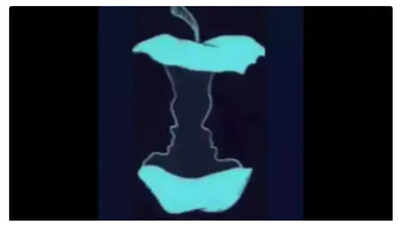Optical illusions are trending due to their ability to stimulate the brain and test observation skills. These visual puzzles provide entertainment and insight. An optical illusion occurs when the brain misinterprets visual information, leading to perceptions that differ from reality. For example, a static image might appear to be in motion.

What do you notice first in this image?
This particular image, shared by Marina Winberg, presents a dual-illusion: an eaten apple or two faces. Your initial perception purportedly unveils a key element of your personality. Examine the image and determine your primary observation before proceeding.
Winberg stated, "This image is a classic dual-illusion where you can either see two faces (a man and a woman) looking at each other OR an apple core—what you notice first says a lot about your mindset!”
If You See Two Faces First
According to Winberg, perceiving the two faces first suggests, “You’re a logical, analytical thinker with strong morals. You think before you act, value stability, and solve problems creatively— but sometimes, curiosity gets the best of you!”
If You See the Apple First
Winberg explains that those who see the apple first are, “intuitive, emotionally aware, and great at reading subtle cues. You know the right thing to say, but often stay quiet. Stability matters to you, and you protect what’s important.”
Different Types of Optical Illusions
Optical illusions are categorized into three primary types:
Older articles
 Earth's Spin Accelerating: Scientists Predict Potential 'Negative Leap Second' by 2029
Earth's Spin Accelerating: Scientists Predict Potential 'Negative Leap Second' by 2029
 5 Subtle Signs of Cervical Cancer Women Often Miss
5 Subtle Signs of Cervical Cancer Women Often Miss
 Hair Oil vs. Hair Serum: Choosing the Right Treatment for Your Hair Type
Hair Oil vs. Hair Serum: Choosing the Right Treatment for Your Hair Type
 New Zealand Announces Packed Home Cricket Schedule Featuring Australia, England, West Indies, and South Africa
New Zealand Announces Packed Home Cricket Schedule Featuring Australia, England, West Indies, and South Africa
 Heart Attack Warning: Key Signs That Can Appear Weeks in Advance
Heart Attack Warning: Key Signs That Can Appear Weeks in Advance
 Steven Smith Targets Test Return After Unique Baseball Cage Recovery in New York
Steven Smith Targets Test Return After Unique Baseball Cage Recovery in New York
 Bollywood's Enduring Fascination with Indian Mythology: From Ramayana to Modern Blockbusters
Bollywood's Enduring Fascination with Indian Mythology: From Ramayana to Modern Blockbusters
 Liver Disease: 5 Subtle Warning Signs You Shouldn't Ignore
Liver Disease: 5 Subtle Warning Signs You Shouldn't Ignore
 Daren Sammy Fined, Receives Demerit Point for Third Umpire Criticism After Test Match
Daren Sammy Fined, Receives Demerit Point for Third Umpire Criticism After Test Match
 Brain Damage Linked to Criminal Behavior: Study Reveals Key Neural Pathway
hoặc
New Study Links Brain Injury to Increased Risk of Criminal Behavior
Brain Damage Linked to Criminal Behavior: Study Reveals Key Neural Pathway
hoặc
New Study Links Brain Injury to Increased Risk of Criminal Behavior